The Real vs. Imaginary in Sunsets in Oia
PART TWO: PLACES
Welcome to Part Two of this blog entry, in which I reveal the aspects of Sunsets in Oia that were inspired by reality and those that are purely fictional. In my last entry, I went into detail about the characters in the novel, but this time around I'll be focusing on the setting.
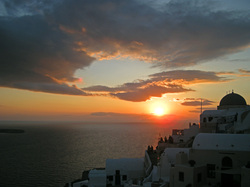 My first sunset view in Oia
My first sunset view in Oia When I first decided to set my first novel on the Greek island of Santorini, there was no question in my mind that I had to return there in order to do the location justice. After all, this isn't an ordinary island. Most travel magazines and bloggers will agree it is one of the most beautiful island destinations around, and the sunset view from the cliffs in Oia is repeatedly reviewed as one of the best in the world.
Writing my book while on the island provided even more spontaneous inspiration than anticipated, which is why so many real-life places are mentioned within the pages of Sunsets in Oia. However, I did take a few liberties with the island's geography in order to satisfy some plot inclusions. So, if you ever travel to the island that inspired my novel, you'll know which places are actually there for you to enjoy and which ones only exist on the page.
Writing my book while on the island provided even more spontaneous inspiration than anticipated, which is why so many real-life places are mentioned within the pages of Sunsets in Oia. However, I did take a few liberties with the island's geography in order to satisfy some plot inclusions. So, if you ever travel to the island that inspired my novel, you'll know which places are actually there for you to enjoy and which ones only exist on the page.
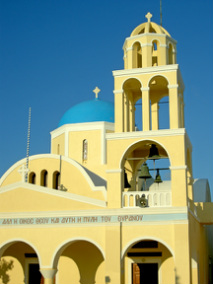 St. George's Church in Oia
St. George's Church in Oia REAL PLACES IN OIA
In Sunsets in Oia, I reference many real places that make this picturesque village unique. One of the most prominently mentioned landmarks is St. George's Church, located near the steps that lead down to Selene's cavehouse. This beautiful church is directly across the street from Laokasti Villas, where I stayed for my writing retreat. Its courtyard also marks the end of the main pedestrian street at the edge of the village. This church is expertly maintained and still welcomes a regular congregation. It's also open to tourists and is available for weddings. In fact, the joke that Georgios makes about gunfire scaring away the bride (page 15) was inspired by something I actually witnessed. During my first day on the island, while sitting out on the veranda in the late afternoon, my writing flow was interrupted by gunfire. Spiro Kokkalis, the owner of Laokasti Villas, explained the tradition to me, and I thought it so unique that I spontaneously included it in the scene I was writing.
Since most of my story takes place in Oia and a great amount of effort was used to describe local cuisine, I felt it important to mention several real restaurants, taverns and cafés. My favourite of these was Terpsi en Oia, where I enjoyed a fabulous dinner and then returned a few other times for lunch or an afternoon drink and snack. I also devoured some phenomenal perogies at Polski Lokal, and had drinks twice at Hasapiko, which is why they made it into the book. The former is run by Polish immigrants, while the latter makes its home in an old butchery that inspired its name. I passed by Argonaut one evening and caught a bit of the live musical performance, but didn't stay long. Still, I was impressed by its colourful and lively energy, so I decided to write it into the book. Additionally, I walked by 1800 and Melenio Café several times during my stay in Oia. While I never ate at either place, their reputations in the village made them worth mentioning.
In Sunsets in Oia, I reference many real places that make this picturesque village unique. One of the most prominently mentioned landmarks is St. George's Church, located near the steps that lead down to Selene's cavehouse. This beautiful church is directly across the street from Laokasti Villas, where I stayed for my writing retreat. Its courtyard also marks the end of the main pedestrian street at the edge of the village. This church is expertly maintained and still welcomes a regular congregation. It's also open to tourists and is available for weddings. In fact, the joke that Georgios makes about gunfire scaring away the bride (page 15) was inspired by something I actually witnessed. During my first day on the island, while sitting out on the veranda in the late afternoon, my writing flow was interrupted by gunfire. Spiro Kokkalis, the owner of Laokasti Villas, explained the tradition to me, and I thought it so unique that I spontaneously included it in the scene I was writing.
Since most of my story takes place in Oia and a great amount of effort was used to describe local cuisine, I felt it important to mention several real restaurants, taverns and cafés. My favourite of these was Terpsi en Oia, where I enjoyed a fabulous dinner and then returned a few other times for lunch or an afternoon drink and snack. I also devoured some phenomenal perogies at Polski Lokal, and had drinks twice at Hasapiko, which is why they made it into the book. The former is run by Polish immigrants, while the latter makes its home in an old butchery that inspired its name. I passed by Argonaut one evening and caught a bit of the live musical performance, but didn't stay long. Still, I was impressed by its colourful and lively energy, so I decided to write it into the book. Additionally, I walked by 1800 and Melenio Café several times during my stay in Oia. While I never ate at either place, their reputations in the village made them worth mentioning.
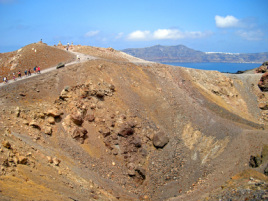 Hikers along the rim of Nea Kameni's active crater
Hikers along the rim of Nea Kameni's active crater OTHER REAL LOCATIONS AROUND SANTORINI
During my writing retreat, I indulged in a few day trips in order to get a taste of some of the adventurous activities and unique locations the rest of the island has to offer. Even though most of Selene's stay on the island is focused in Oia, I wanted to show that the rest of the island is full of magical locations and plenty of charm.
My second day on the island was spent tramping around Nea Kameni, the still-active volcano island in the middle of the caldera. The description included in the book (page 83) about the ground sizzling under Selene's feet actually happened to me! It was certainly the most unique and breathtaking hiking experience I've had so far in my life.
During my writing retreat, I indulged in a few day trips in order to get a taste of some of the adventurous activities and unique locations the rest of the island has to offer. Even though most of Selene's stay on the island is focused in Oia, I wanted to show that the rest of the island is full of magical locations and plenty of charm.
My second day on the island was spent tramping around Nea Kameni, the still-active volcano island in the middle of the caldera. The description included in the book (page 83) about the ground sizzling under Selene's feet actually happened to me! It was certainly the most unique and breathtaking hiking experience I've had so far in my life.
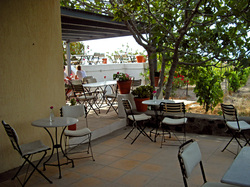 The patio at Domaine Sigalas
The patio at Domaine Sigalas I also enjoyed another afternoon trip to nearby Baxedes and spent a few hours sipping wine next to a fig tree on the patio at Domaine Sigalas. Wines produced on Santorini are some of the most unique in Europe -- not only for the traditional "koulara" pruning technique, but also because the volcanic soil helps produce very unique flavours. I modelled Selene and Nikos' experience at Domaine Sigalas after my own (although, unlike Selene, I can handle my wine and managed to leave under my own power). I tried many wines from several local vineyards during my stay on Santorini, but my tongue still fondly remembers the taste of the vinsanto from Domaine Sigalas. Sadly, it is a rare commodity off the island.
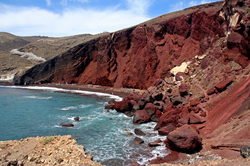 Akrotiri's famous Red Beach
Akrotiri's famous Red Beach My third and final day trip took me to Akrotiri. While visiting the Akrotiri Archaeological Site was certainly fascinating, it couldn't compare to the natural beauty I witnessed after following a coastline road and then a dirt path to discover Santorini's secluded, iconic Red Beach. There are no words to describe its majesty!
A few other real locations were mentioned in the book that, unfortunately, I never had the pleasure of visiting during my stay. I wrote them into the novel using only the information available to me through tourist guidebooks and websites. These include Perivolos Beach, Ntomatini Restaurant in Perissa, and Nostos music shop in Fira. I must give extra credit to my friend Lewis, the young man assisting the Kokkalis family that summer at Laokasti Villas. After I returned to Canada, I found myself in need of detailed information about Emporio, but what was available online was scarce. Lewis used one of his rare days off to travel to the village, taking photos of it for me and sending me a detailed email about what he saw there. The scene when Selene and Nikos visit Emporio and its windmills couldn't have happened without Lewis' efforts.
FICTIONAL MANIPULATIONS OF SANTORINI
I admittedly took some liberties with the island's geography in order to enable a few crucial moments in Sunsets in Oia. Probably the most important fake location is Selene's favourite spot: the rock that juts out from the cliffside several metres below her Oia cavehouse. While this rock is referenced several times throughout the novel, it is not based on an actual spot I found during my writing retreat. However, that's not to say an adventurous off-trail trekker couldn't find something similar in such a location.
Similarily, Selene's private strip of beach at the end of a path that leads down the cliffside from her cavehouse does not, from my knowledge, exist. I wandered many of the sets of stairs that lead to the lower cavehouses in the village and never found one in the area that goes all the way to the waters of the caldera.
Lastly, I will write about my creation of one of Sunsets in Oia's most notable eateries: Uncle Pavlo's restaurant, Bougainvillea. This place, sadly, doesn't exist; however, I modelled it after a combination of experiences I had at traditional restaurants and taverns in the village.
I hope this blog entry inspires those who visit Santorini to seek out some of the real-life locations I've mentioned. In my opinion, they are certainly worth your time. Happy travels!
A few other real locations were mentioned in the book that, unfortunately, I never had the pleasure of visiting during my stay. I wrote them into the novel using only the information available to me through tourist guidebooks and websites. These include Perivolos Beach, Ntomatini Restaurant in Perissa, and Nostos music shop in Fira. I must give extra credit to my friend Lewis, the young man assisting the Kokkalis family that summer at Laokasti Villas. After I returned to Canada, I found myself in need of detailed information about Emporio, but what was available online was scarce. Lewis used one of his rare days off to travel to the village, taking photos of it for me and sending me a detailed email about what he saw there. The scene when Selene and Nikos visit Emporio and its windmills couldn't have happened without Lewis' efforts.
FICTIONAL MANIPULATIONS OF SANTORINI
I admittedly took some liberties with the island's geography in order to enable a few crucial moments in Sunsets in Oia. Probably the most important fake location is Selene's favourite spot: the rock that juts out from the cliffside several metres below her Oia cavehouse. While this rock is referenced several times throughout the novel, it is not based on an actual spot I found during my writing retreat. However, that's not to say an adventurous off-trail trekker couldn't find something similar in such a location.
Similarily, Selene's private strip of beach at the end of a path that leads down the cliffside from her cavehouse does not, from my knowledge, exist. I wandered many of the sets of stairs that lead to the lower cavehouses in the village and never found one in the area that goes all the way to the waters of the caldera.
Lastly, I will write about my creation of one of Sunsets in Oia's most notable eateries: Uncle Pavlo's restaurant, Bougainvillea. This place, sadly, doesn't exist; however, I modelled it after a combination of experiences I had at traditional restaurants and taverns in the village.
I hope this blog entry inspires those who visit Santorini to seek out some of the real-life locations I've mentioned. In my opinion, they are certainly worth your time. Happy travels!
 RSS Feed
RSS Feed
